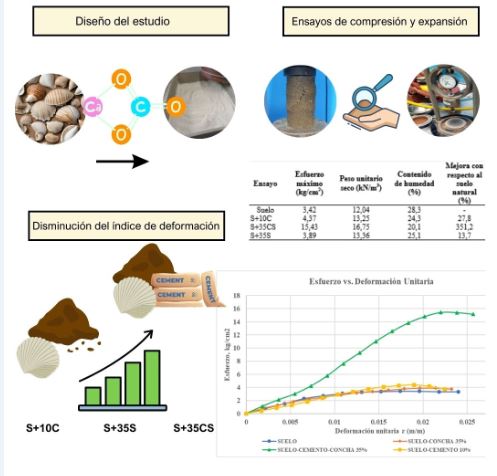Stabilization of Expansive Soils in Panama with Seashell Residue Mixtures
##plugins.themes.bootstrap3.article.main##
Abstract
Expansive soils are characteristic of tropical regions, presenting great volumetric changes when their water content varies. These changes usually present structural problems in the foundations caused directly by the behavior of the material on which they have been built. Cementitious materials are used to control expansion in soils such as calcium carbonate (CaCO3), that is mineral found in many parts of the planet. The exoskeletons of marine animals, waste of industrial activities such as fishing and the extraction of sea sand, that could be reused as a rich source of CaCO3. The objective of this study is to evaluate the feasibility for the stabilization of expansive soils in Panama, through controlled compaction and the addition of stabilizers such as seashell and cement, and thus determine the optimal proportion in the expansive land of the study, according to SDG 12 Responsible production and consumption. The expansive soil, the chemical composition of the soil and the seashell were characterized, and the maximum stress to be supported was determined through the unconfined compression test of the expansive soil with the additions made to determine the optimal mixture and proportion of stabilization. The 35 % cement/seashell mixture was obtained as the best results, this shows feasibility for the use of seashell waste as a cementing material for the stabilization of expansive soils in Panama.
##plugins.themes.revistapolitecnica.stadistisDownloadTitle##
Downloads
Article Details
References
Anggraini, V., Dassanayake, S., Emmanuel, E., Yong, L., Kamaruddin, F., & Syamsir, A. (2023). Response Surface Methodology: The Improvement of Tropical Residual Soil Mechanical Properties Utilizing Calcined Seashell Powder and Treated Coir Fibre. Sustainability, 15(4), 3588. https://doi.org/10.3390/su15043588
Arango Campo, S. E. (2020). Mezcla puzolánica y composición cementante. https://patentimages.storage.googleapis.com/d3/2c/6a/6e35abe309f83f/WO2020208552A1.pdf
American Society for Testing and Materials. (2016). Standard Test Method for Resistance to Degradation of Large-Size Coarse Aggregate by Abrasion and Impact in the Los Angeles Machine. (ASTM Standar No. C535-16).
American Society for Testing and Materials. (2016). Standard Test Method for Unconfined Compressive Strength of Cohesive Soil. (ASTM Standar No. D2166/D2166M-16).
American Society for Testing and Materials. (2020). Standard Test Method for Sieve Analysis of Fine and Coarse Aggregates. (ASTM Standar No. C136/C136M-19).
American Society for Testing and Materials. (2021). Standard Test Methods for Laboratory Compaction Characteristics of Soil Using Standard Effort (12,400 ft-lbf/ft3 (600 kN-m/m3)). (ASTM Standar No. D698-12R21).
American Society for Testing and Materials. (2021). Standard Test Method for Particle-Size Distribution (Gradation) of Fine-Grained Soils Using the Sedimentation (Hydrometer) Analysis. (ASTM Standar No. D7928-21e1).
Chilakala, R., Thannaree, C., Shin, E. J., Thenepalli, T., & Ahn, J. (2019). Sustainable Solutions for Oyster Shell Waste Recycling in Thailand and the Philippines. Recycling, 4(3), 35. https://doi.org/10.3390/recycling4030035
Delgado Trujillo, A. (1986). Influencia de la trayectoria de las tensiones en el comportamiento de las arcillas expansivas y de los suelos colapsables en el laboratorio y en el terreno. https://idus.us.es/handle/11441/24350
INEC. (n.d.). Precipitación pluvial registrada en las estaciones meteorológicas de la República, según provincia, comarca indígena y estación: años 2066-15. https://www.inec.gob.pa/archivos/P8211121-01.pdf
Merchan Infante, S. D. (2009). Comportamiento de suelos expansivos en cimentaciones superficiales. https://repositorio.uniandes.edu.co/handle/1992/11460
Molina, U. C. (22 de Noviembre de 2020). MiAmbiente reconoce las causas que provocaron el desastre en Tierras Altas y preparan plan de prevención. TVN Panamá. https://www.tvn-2.com/contenido-exclusivo/ministerio-ambiente-causas-desastre-tierras-altas-chiriqui-plan-prevencion_1_1052812.html
Rivera Pérez, C., & Hernández Saavedra, N. Y. (2020). ¿Cómo se forma la concha de los moluscos? Recursos Naturales y Sociedad, 6(1), 43-54. https://www.cibnor.gob.mx/revista-rns/pdfs/vol6num1/4_COMO_FORMA.pdf
Ruíz, G., & Farfán, P. (2016). Use of crushed seashell by-products for sandy subgrade stabilization for pavement purpose. 14th LACCEI International Multi-Conference for Engineering, Education, and Technology: “Engineering Innovations for Global Sustainability”. http://dx.doi.org/10.18687/LACCEI2016.1.1.053
Sanjuán Barbudo, M. Á., & Chinchón Yepes, S. (2014). Introducción a la fabricación y normalización del cemento portland. https://rua.ua.es/dspace/handle/10045/45347
Asociación Española de Normalización. (2020). Determinación de la expansividad de un suelo en el aparato Lambe. (UNE Estándar No. 103600:1996).
Vinod, B. R., Shobha, R., Raghavendra, A. B., Rakesh, M., & Pallavi, S. (2020). Stabilization on Expansive soil using sea shell powder and Rubber powder. IOP Conference Series: Materials Science and Engineering, 814. https://iopscience.iop.org/article/10.1088/1757-899X/814/1/012028/meta




